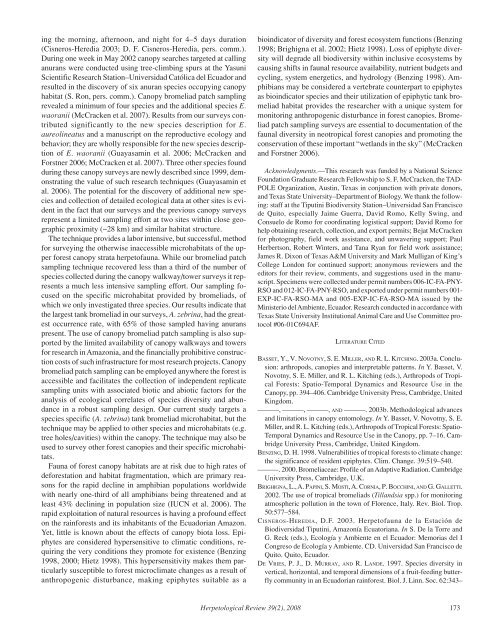Herpetological Review Herpetological Review - Doczine
Herpetological Review Herpetological Review - Doczine
Herpetological Review Herpetological Review - Doczine
You also want an ePaper? Increase the reach of your titles
YUMPU automatically turns print PDFs into web optimized ePapers that Google loves.
ing the morning, afternoon, and night for 4–5 days duration(Cisneros-Heredia 2003; D. F. Cisneros-Heredia, pers. comm.).During one week in May 2002 canopy searches targeted at callinganurans were conducted using tree-climbing spurs at the YasuniScientific Research Station–Universidad Católica del Ecuador andresulted in the discovery of six anuran species occupying canopyhabitat (S. Ron, pers. comm.). Canopy bromeliad patch samplingrevealed a minimum of four species and the additional species E.waoranii (McCracken et al. 2007). Results from our surveys contributedsignificantly to the new species description for E.aureolineatus and a manuscript on the reproductive ecology andbehavior; they are wholly responsible for the new species descriptionof E. waoranii (Guayasamin et al. 2006; McCracken andForstner 2006; McCracken et al. 2007). Three other species foundduring these canopy surveys are newly described since 1999, demonstratingthe value of such research techniques (Guayasamin etal. 2006). The potential for the discovery of additional new speciesand collection of detailed ecological data at other sites is evidentin the fact that our surveys and the previous canopy surveysrepresent a limited sampling effort at two sites within close geographicproximity (~28 km) and similar habitat structure.The technique provides a labor intensive, but successful, methodfor surveying the otherwise inaccessible microhabitats of the upperforest canopy strata herpetofauna. While our bromeliad patchsampling technique recovered less than a third of the number ofspecies collected during the canopy walkway/tower surveys it representsa much less intensive sampling effort. Our sampling focusedon the specific microhabitat provided by bromeliads, ofwhich we only investigated three species. Our results indicate thatthe largest tank bromeliad in our surveys, A. zebrina, had the greatestoccurrence rate, with 65% of those sampled having anuranspresent. The use of canopy bromeliad patch sampling is also supportedby the limited availability of canopy walkways and towersfor research in Amazonia, and the financially prohibitive constructioncosts of such infrastructure for most research projects. Canopybromeliad patch sampling can be employed anywhere the forest isaccessible and facilitates the collection of independent replicatesampling units with associated biotic and abiotic factors for theanalysis of ecological correlates of species diversity and abundancein a robust sampling design. Our current study targets aspecies specific (A. zebrina) tank bromeliad microhabitat, but thetechnique may be applied to other species and microhabitats (e.g.tree holes/cavities) within the canopy. The technique may also beused to survey other forest canopies and their specific microhabitats.Fauna of forest canopy habitats are at risk due to high rates ofdeforestation and habitat fragmentation, which are primary reasonsfor the rapid decline in amphibian populations worldwidewith nearly one-third of all amphibians being threatened and atleast 43% declining in population size (IUCN et al. 2006). Therapid exploitation of natural resources is having a profound effecton the rainforests and its inhabitants of the Ecuadorian Amazon.Yet, little is known about the effects of canopy biota loss. Epiphytesare considered hypersensitive to climatic conditions, requiringthe very conditions they promote for existence (Benzing1998, 2000; Hietz 1998). This hypersensitivity makes them particularlysusceptible to forest microclimate changes as a result ofanthropogenic disturbance, making epiphytes suitable as abioindicator of diversity and forest ecosystem functions (Benzing1998; Brighigna et al. 2002; Hietz 1998). Loss of epiphyte diversitywill degrade all biodiversity within inclusive ecosystems bycausing shifts in faunal resource availability, nutrient budgets andcycling, system energetics, and hydrology (Benzing 1998). Amphibiansmay be considered a vertebrate counterpart to epiphytesas bioindicator species and their utilization of epiphytic tank bromeliadhabitat provides the researcher with a unique system formonitoring anthropogenic disturbance in forest canopies. Bromeliadpatch sampling surveys are essential to documentation of thefaunal diversity in neotropical forest canopies and promoting theconservation of these important “wetlands in the sky” (McCrackenand Forstner 2006).Acknowledgments.—This research was funded by a National ScienceFoundation Graduate Research Fellowship to S. F. McCracken, the TAD-POLE Organization, Austin, Texas in conjunction with private donors,and Texas State University–Department of Biology. We thank the following:staff at the Tiputini Biodiversity Station–Universidad San Franciscode Quito, especially Jaime Guerra, David Romo, Kelly Swing, andConsuelo de Romo for coordinating logistical support; David Romo forhelp obtaining research, collection, and export permits; Bejat McCrackenfor photography, field work assistance, and unwavering support; PaulHerbertson, Robert Winters, and Tana Ryan for field work assistance;James R. Dixon of Texas A&M University and Mark Mulligan of King’sCollege London for continued support; anonymous reviewers and theeditors for their review, comments, and suggestions used in the manuscript.Specimens were collected under permit numbers 006-IC-FA-PNY-RSO and 012-IC-FA-PNY-RSO, and exported under permit numbers 001-EXP-IC-FA-RSO-MA and 005-EXP-IC-FA-RSO-MA issued by theMinisterio del Ambiente, Ecuador. Research conducted in accordance withTexas State University Institutional Animal Care and Use Committee protocol#06-01C694AF.LITERATURE CITEDBASSET, Y., V. NOVOTNY, S. E. MILLER, AND R. L. KITCHING. 2003a. Conclusion:arthropods, canopies and interpretable patterns. In Y. Basset, V.Novotny, S. E. Miller, and R. L. Kitching (eds.), Arthropods of TropicalForests: Spatio-Temporal Dynamics and Resource Use in theCanopy, pp. 394–406. Cambridge University Press, Cambridge, UnitedKingdom.––––––, ––––––, ––––––, AND ––––––. 2003b. Methodological advancesand limitations in canopy entomology. In Y. Basset, V. Novotny, S. E.Miller, and R. L. Kitching (eds.), Arthropods of Tropical Forests: Spatio-Temporal Dynamics and Resource Use in the Canopy, pp. 7–16. CambridgeUniversity Press, Cambridge, United Kingdom.BENZING, D. H. 1998. Vulnerabilities of tropical forests to climate change:the significance of resident epiphytes. Clim. Change. 39:519–540.––––––. 2000. Bromeliaceae: Profile of an Adaptive Radiation. CambridgeUniversity Press, Cambridge, U.K.BRIGHIGNA, L., A. PAPINI, S. MOSTI, A. CORNIA, P. BOCCHINI, AND G. GALLETTI.2002. The use of tropical bromeliads (Tillandsia spp.) for monitoringatmospheric pollution in the town of Florence, Italy. Rev. Biol. Trop.50:577–584.CISNEROS-HEREDIA, D.F. 2003. Herpetofauna de la Estación deBiodiversidad Tiputini, Amazonía Ecuatoriana. In S. De la Torre andG. Reck (eds.), Ecología y Ambiente en el Ecuador: Memorias del ICongreso de Ecología y Ambiente. CD. Universidad San Francisco deQuito. Quito, Ecuador.DE VRIES, P. J., D. MURRAY, AND R. LANDE. 1997. Species diversity invertical, horizontal, and temporal dimensions of a fruit-feeding butterflycommunity in an Ecuadorian rainforest. Biol. J. Linn. Soc. 62:343–<strong>Herpetological</strong> <strong>Review</strong> 39(2), 2008 173














